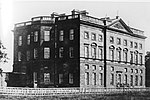St Mary's Collegiate Church, Haddington
15th-century church buildings in ScotlandCategory A listed buildings in East LothianChurches completed in 1410Churches in East LothianCollegiate churches in Scotland ... and 5 more
E. W. Pugin church buildingsHaddington, East LothianListed churches in ScotlandRenaissance architecture in ScotlandShrines to the Virgin Mary

The Collegiate Church of St Mary the Virgin is a Church of Scotland parish church in Haddington, East Lothian, Scotland. Building work on the church was started in 1380, and further building and rebuilding has taken place up to the present day. It is the longest church in Scotland, at 206 feet (62.8 metres) from east to west, and is in the early Gothic style.
Excerpt from the Wikipedia article St Mary's Collegiate Church, Haddington (License: CC BY-SA 3.0, Authors, Images).St Mary's Collegiate Church, Haddington
Sidegate,
Geographical coordinates (GPS) Address Nearby Places Show on map
Geographical coordinates (GPS)
| Latitude | Longitude |
|---|---|
| N 55.9532 ° | E -2.7719 ° |
Address
Sidegate
EH41 4BT
Scotland, United Kingdom
Open on Google Maps








